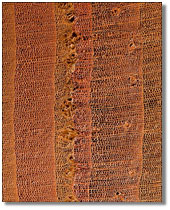 |
|
|
 |
||
|
||||||||||||||
|
NSF, Science Name Winners of Inaugural International Science & Engineering Visualization Challenge
|
|
|
|
ARLINGTON, Va.—The National Science Foundation and the journal Science today announced the winners of the inaugural 2003 Science and Engineering Visualization Challenge.
The winning entries are featured in today's issue of Science and in the journal's electronic edition "Science Online."
"Science commends all of the winners of the first Science and Engineering Visualization Challenge," said Monica M. Bradford, Executive Editor of Science. "The magnificence of scientific discovery is revealed in the winning visualizations. Each work represents an important contribution toward helping to promote public engagement in the scientific concepts that are at the core of modern life."
Two hundred ninety-seven entries qualified for judging. A panel of distinguished science communicators judged the entries on technical accuracy, creativity, innovation and communication impact.
The 2003 Science and Engineering Visualization Challenge winners are:
Active and/or Multimedia Category
First place: "Auditory Transduction Animation," by Brandon Pletsch, Medical College of Georgia. Medical illustrator Petsch’s animation takes viewers into and through a symphonic journey of the human ear.
Runner-up: "Volume Visualization of the Orion Nebulae," by David Nadeau, University of California - San Diego (Contributors: Jon Genetti, Carter Emmart). A three-dimensional animation of the 1,500 light years distant Orion Nebulae created by a team from the San Diego Supercomputing Center and New York's American Museum of Natural History from real astronomical data and imagery.
Third place: "Milankovitch Cycle," by Dennis Tasa, Tasa Graphic Arts, Inc., Taos, N.M. (Contributor: Frank Pazzaglia). Tasa's instructional tool combines the three major portions of the Milankovitch cycles with interactivity to teach students about natural climate variables.
Honorable mention: "The Creation of Earth," by Carter Emmart, American Museum of Natural History, New York (Contributors: Anthony Braun, Mordecai-Mark MacLow, James Sweitzer, Edmond Mathez, Michael Novacek & Neil deGrasse Tyson). Emmart and team built this three-dimensional modeling of the possible formation of the universe. It is narrated by actor Harrison Ford.
Photographs Category
First place: "Mongolian Frost Rings," by Dee Breger, SEM/EDX Facility, Palisades, N.Y. Breger's colorized photograph of a Siberian pine tree core sample from Mongolia, taken with a scanning electron microscope, told the tale of a catastrophic climate change linked to a massive volcanic eruption.
Runner-up: "Black Sea Pyrite," by Dee Breger, SEM/EDX Facility, Palisades, N.Y. Breger captured the forming of a tiny cluster of pyrite crystals inside a microplankton found in the oxygen-free sediment of the Black Sea. The selectively colorized image was taken using a scanning electron microscope.
Third place: No award.
Honorable mention: "Buckling of a Multi-Wall Nanotube," by Michael Stadermann, University of North Carolina, Chapel Hill, N.C. (Contributors: Mike Falvo, Sean Washburn, and Richard Superfine). A novel technique called "conductance-imaging atomic force microscopy" was used by Stadermann to photograph a carbon nanotube atop a silicon surface at the atomic level.
Illustrations Category
First place: "Innolab 3D File Manager," by Adam Miezianko, Boston University, Brookline, Mass. (Contributors: Kristopher Rambish, Karen Fung & Zaunura Pingkan). Miezianko illustrates the organization of computer contents in a unique arrangement reminiscent of a Ferris wheel.
Runner-up: "Macrophage and Bacterium 2,000,000x," by David Goodsell, The Scripps Research Institute, LaJolla, Calif. Goodsell's unique multi-canvas watercolor interpretation of an immune system cell destroying a bacterium in the bloodstream.
Third place: No award.
Honorable mention: "Cytokines in Hematopoiesis and Development poster," by Erin Pascoe, R&D; Systems, Inc., Minneapolis (Contributors: Jennifer Harrington, Daphne Orlando, and Gregg Hickey). Embryonic hematopoiesis and the generation of hematopoietic stem cells as illustrated by Harrington, Orlando and Hickey.
NSF's SEVC site: http://www.nsf.gov/od/lpa/events/sevc/
The journal Science online slide show: www.sciencemag.org/feature/data/vis2003/
Science print articles:
Introduction -- www.sciencemag.org/cgi/content/full/301/5639/1472a
Photo winners -- www.sciencemag.org/cgi/content/full/301/5639/1472b
Multimedia winners -- www.sciencemag.org/cgi/content/full/301/5639/1474
Illustration winners -- www.sciencemag.org/cgi/content/full/301/5639/1476
The National Science Foundation (NSF) is an independent federal agency that supports fundamental research and education across all fields of science and engineering, with an annual budget of nearly $5.3 billion. NSF funds reach all 50 states through grants to nearly 2,000 universities and institutions. Each year, NSF receives about 30,000 competitive requests for funding, and makes about 10,000 new funding awards. The NSF also awards over $200 million in professional and service contracts yearly.
Receive official NSF news electronically through the e-mail delivery system, NSFnews. To subscribe, send an e-mail message to join-nsfnews@lists.nsf.gov. In the body of the message, type "subscribe nsfnews" and then type your name. (Ex.: "subscribe nsfnews John Smith")
Useful NSF Web Sites:
NSF Home Page: http://www.nsf.gov
News Highlights: http://www.nsf.gov/od/lpa
Newsroom: http://www.nsf.gov/od/lpa/news/media/start.htm
Science Statistics: http://www.nsf.gov/sbe/srs/stats.htm
Awards Searches: http://www.fastlane.nsf.gov/a6/A6Start.htm
|
|
